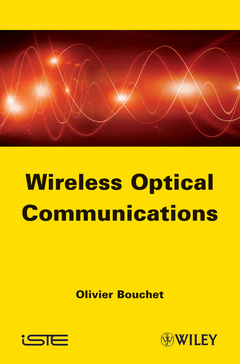Wireless Optical Communications
Auteur : Bouchet Olivier

Wireless optical communication refers to communication based on the unguided propagation of optical waves. The past 30 years have seen significant improvements in this technique ? a wireless communication solution for the current millennium ? that offers an alternative to radio systems; a technique that could gain attractiveness due to recent concerns regarding the potential effects of radiofrequency waves on human health.
The aim of this book is to look at the free space optics that are already used for the exchange of current information; its many benefits, such as incorporating channel properties, propagation models, link budgets, data processing including coding, modulation, standards and concerns around health and safety (IEC 60825 or FCC - Class 1 for example), etc. will become indispensable over the next decade in addressing computer architectures for short-, medium- and long-range telecommunications as we move from gigabytes to terabytes per second.
Wireless Optical Communications is an excellent tool for any engineer wanting to learn about wireless optical communications or involved in the implementation of real complete systems. Students will find a wide range of information and useful concepts such as those relating to propagation, optics and photometry, as well the necessary information on safety.
Contents
1. Light.
2. History of Optical Telecommunications.
3. The Contemporary and the Everyday Life of Wireless Optical Communication.
4. Propagation Model.
5. Propagation in the Atmosphere.
6. Indoor Optic Link Budget.
7. Immunity, Safety, Energy and Legislation.
8. Optics and Optronics.
9. Data Processing.
10. Data Transmission.
11. Installation and System Engineering.
12. Conclusion.
Foreword.xi
Pierre-Noël FAVENNEC
Acronyms xiii
Introduction.xix
Chapter 1. Light 1
Chapter 2. History of Optical Telecommunications 7
2.1. Some definitions 7
2.2. The prehistory of telecommunications 8
2.3. The optical aerial telegraph 11
2.4. The code 14
2.5. The optical telegraph 18
2.6. Alexander Graham Bell’s photophone 20
Chapter 3. The Contemporary and the Everyday Life of Wireless Optical Communication 25
3.1. Basic principles 25
3.2. Wireless optical communication 53
Chapter 4. Propagation Model 63
4.1. Introduction.63
4.2. Baseband equivalent model 63
4.3. Diffuse propagation link budget in a confined environment 73
Chapter 5. Propagation in the Atmosphere 85
5.1. Introduction.85
5.2. The atmosphere 86
5.3. The propagation of light in the atmosphere 87
5.4. Models.93
5.5. Experimental set-up 103
5.6. Experimental results.104
5.7. Fog, haze, and mist 107
5.8. The runway visual range (RVR) 108
5.9. Calculating process of an FSO link availability 114
5.10. Conclusion 116
Chapter 6. Indoor Optic Link Budget.119
6.1. Emission and reception parameters 119
6.2. Link budget for line of sight communication 128
6.3. Link budget for communication with retroreflectors.132
6.4. Examples of optical budget and signal-to-noise ratio (SNR) 135
Chapter 7. Immunity, Safety, Energy and Legislation 141
7.1. Immunity 141
7.2. The confidentiality of communication 149
7.3. Energy 153
7.4. Legislation 154
Chapter 8. Optics and Optronics 157
8.1. Overview 157
8.2. Optronics: transmitters and receivers.157
8.3. Optics 170
Chapter 9. Data Processing 177
9.1. Introduction.177
9.2. Modulation 178
9.3. The coding 184
Chapter 10. Data Transmission 197
10.1. Introduction 197
10.2. Point-to-point link 201
10.3. Point-to-multipoint data link 206
10.4. Summary 212
Chapter 11. Installation and System Engineering 213
11.1. Free-space optic system engineering and installation 213
11.2. Wireless optical system installation engineering in limited space 225
Chapter 12. Conclusion.237
APPENDICES 241
Appendix 1. Geometrical Optics, Photometry and Energy Elements 243
Appendix 2. The Decibel Unit (dB) 257
Bibliography 261
List of Figures 273
List of Tables 277
List of Equations 279
Index 283
Date de parution : 05-2012
Ouvrage de 320 p.
16.5x24.1 cm



